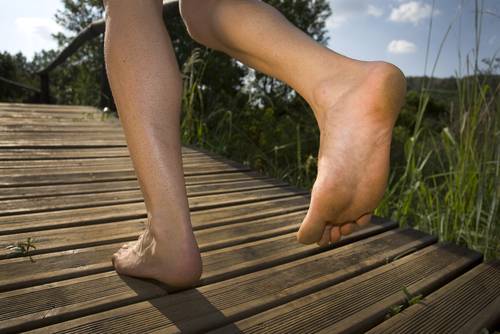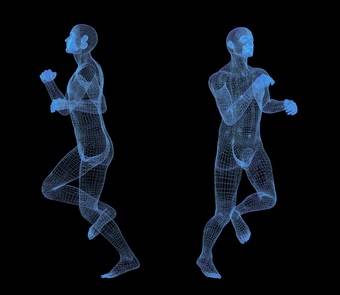Take a large inflated ball like an exercise ball and press down hard on it. When you release the pressure, what happens? It springs back. Indeed, if you press with enough force not only will the area where you were pressing spring back, but often the entire ball will spring off the ground. As an example, have you ever seen a tennis player “pick up” a ball that is lying on the ground by hitting it into the ground with their racket and it springing up? Exactly the same thing (and if you learn nothing else from this article you have now learned an easy way to pick up a tennis ball without reaching down all the way.)
Muscle-Shortening Reflex
Muscles and even tendons within the body work in exactly the same way. When they are compressed, they automatically spring back to their original length. This is called the muscle-shortening reflex. In the same way as with the exercise ball or tennis ball, this stored energy in our body is automatically released.
Try this simple drill:
Stand up, and jump up and down with your body relatively straight. Essentially, bounce on a spot like you would when jumping rope.
Now try the same thing but with a slight pause between jumps.
Which feels easier?
In the first set of jumps, we are initially required to generate power (energy) to leave the ground. But as we land, energy that is created by gravity is stored in the body and then released by the muscle-shortening reflex to allow us to spring back up. This continues for as long as we continue jumping.
In the second set of jumps, we are required to generate power (energy) in order to leave the ground. When we land and pause, the energy created by gravity is dissipated or wasted into the ground and we now need to create all of the energy required to jump off the ground again. The pause causes us to waste the natural energy
By storing energy created by the action of gravity on our body we have a free energy source that we can tap into when running. The best example of this is the Australian kangaroo, which can hop at up to 70kph using this natural energy. This stored energy can, however, dissipate and be wasted quickly and this loss of energy, like the jumping example, be attributed to one thing – ground contact time.
Ground Contact Time
Like the example, the longer we stay on the ground the more of this energy is wasted. However, in order to reduce contact time we actually need to negate, or rather placate a built-in safely switch in our body. Because our brain won’t let our body leave the ground until it feels safe and secure.
 Within the mid-foot are a large number of nerves that are essentially the pressure sensors for our brain. When these nerves register that we are secure, then the brain will then allow other muscles to contract for the foot to leave the ground. The time it takes for these nerves to a) register they are secure and b) tell the brain can be enough to waste the precious energy stored within the muscles that is waiting to be released.
Within the mid-foot are a large number of nerves that are essentially the pressure sensors for our brain. When these nerves register that we are secure, then the brain will then allow other muscles to contract for the foot to leave the ground. The time it takes for these nerves to a) register they are secure and b) tell the brain can be enough to waste the precious energy stored within the muscles that is waiting to be released.
There are two ways we can improve this:
1. Choice of Footwear
This may sound strange but our choice of footwear can delay the pressure-sensing nerves from registering. Shoes with a softer, spongier mid-foot actually cause the foot to press harder into the foam in order to register as it searches for the ground. While obviously these shoes are softer on the bones, the ligaments within the foot in a thicker, softer mid-footed shoe typically have higher ground contact time than with a thinner shoe. Part of the science behind shoes like Newtons is using a thinner membrane under the mid foot to rapidly register with these nerves that the foot is good to go.
Coach’s Tip: Use a shoe with a thinner or firmer mid foot to more rapidly register solid ground contact
2. Higher Cadence
Higher leg turnover facilitates lighter ground contact. With less force through the foot, the need for a secure base is less. Higher cadence also facilitates the muscle-shortening reflex in other muscles such as the deltoids, providing further free speed. Higher cadence doesn’t necessarily mean running faster, though. Think about a bicycle – it is easy to change speed while maintaining exactly the same cadence simply through the choice of gears. Similarly, small steps in endurance running allow for a higher cadence and better usage of the muscle-shortening reflex.
Most studies on the live time of the muscle-shortening reflex – the time before this reflex dissipates – show it is best enabled using a cadence of around 180-190 steps per minute. Most modern running watches support using a foot pod that can display cadence and provide alerts when cadence is too low or high. But an investment in a foot pod isn’t mandatory. Simply count your steps for fifteen seconds when running and aim for 45-46 steps in this time.
Coaches Tip: It is often easier to just count one foot striking the ground. Just halve the number of steps you are aiming for.
 A logical thought is that if a higher cadence is good, than a higher cadence is even better. To a point this is correct, but there is a natural limit on how fast a muscle can move or respond. High-speed firing of a nerve for an extended period of time leads to nerve fatigue. Trying to maintain a cadence close to 100 for an extended period of time is close to impossible.
A logical thought is that if a higher cadence is good, than a higher cadence is even better. To a point this is correct, but there is a natural limit on how fast a muscle can move or respond. High-speed firing of a nerve for an extended period of time leads to nerve fatigue. Trying to maintain a cadence close to 100 for an extended period of time is close to impossible.
“The faster the cadence, the faster the runner” isn’t quite correct. It would be easy to think that if you are running at 188 steps a minute at 5:00min/km, then an Olympic marathon runner running at 3:00min/km must have a much higher cadence. The truth is that Olympic marathon runners also have a cadence of 188 steps a minute. The difference is in how far they travel with each step.
We can illustrate this with a simple math problem:
At 5mins/km it takes you about 3 hours and 31 minutes to run a marathon (211 minutes). This means you take 211 x 188 = 39,668 steps to cover 42,200m, which means each step is 1.06 meters long
An Olympic marathon runner at 3min/km takes 2 hours and 6 minutes to run a marathon (126 minutes). This means he or she takes 23,688 steps to cover 42,200 , which means each step is 1.78 meters long.
So, the difference between an Olympic runner’s stride and an average runner’s stride is 72cm!
Before we discuss how to increase your cadence and increase your stride length, let’s have one more look at those numbers, especially when it comes to choice of footwear. Consider a normal running shoe weighs around 300g. A marathon-racing shoe (not a sprinter’s or 5km runner’s shoe – they are even lighter) weighs around 200g. This may not seem significant. 100g isn’t much, but when we consider we need to lift this 39,668 times, then the difference between the two shoes is actually 3966kg of extra weight you need to move. In fact, it’s actually a bit worse than this as the foot and shoe are moving in a circle and therefore have rotational mass. So a lighter shoes is not only better for assisting the muscle-shortening reflex, but also puts a lot less load on the hip flexors.
By raising cadence, a runner’s efficiency increases greatly. It’s a common misconception that a higher cadence requires more energy where, as can be seen from the muscle-shortening explanation, reality is actually the opposite case – a higher cadence is more efficient.
Photos courtesy of Shutterstock.






